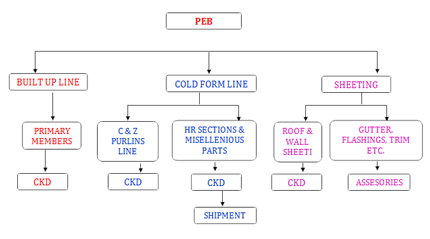- Home
- Profile
- Our Valued Customers
- Products
- SEMCO Safety views
- Enquiry
- Contact
BRIEF HISTORY :- A] Steel was very expensive item in USA.
A] Steel was very expensive item in USA.
B] The concept of PEB originate from here.
C] The idea was that section should be provided as per B.M.D.
D] This lead was the saving in steel and development of PEB concept.
ADVANTAGES :-
• Aesthetic Appeal
• Faster Completion
• Economical
• Seismic Resistance
• Ease of Expansion
• Maintenance Free
• Large Clear Spans
• Controlled Quality
• Hassle Free
APPLICATIONS :-
• Industrial Buildings
• Warehouses
• Commercial Complexes
• Showrooms
• Offices
• Service Industries :- Hotels,Resorts & Clubs
• Schools
• Indoor Stadiums
• Outdoor Stadiums with canopies
• Gas Stations
• Metro Stations, Bus Terminals, Parking Lots
• Primary Health Centers, Angan Wadi’s
And many
more…
| • Self weight | • Self weight |
| • 30%lighter | • More heavy |
| • Primary member is tapered section | • Primary member are hot rolled “I” section |
| • Secondary member are light weight rolled framed “Z” and “C” section |
• Secondary member are “I” or “C” section which are heavy in weight |
| • Delivery – average 6 to 8 weeks | • Delivery – average 20 to 26 weeks |
| • Foundation – simple design, easy to construct & light wt. | • Foundation – expensive, heavy foundation required. |
| • Erection cost & time – accurately known | • Erection cost & time – 20% more thanPEB |
| • Erection process is easy, fast step by step | • Erection process is slow & extensive field labor is required. |
| • Erection process is slow & extensive field labor is required. | • Seismic resistance – rigid heavy weight structures do not perform well in seismic zones |
| • Overall price -30% lower | • Overall price- higher price per square meter. |
| • Architecture – achieved at low cost | • Architecture – achieved at higher cost |
STEPS OF DESIGN :-
Wind load calculation
• Purline Design
• Girt Design
• Design of main frame
• Base Plate
• Anchor Bolt design for moment condition
• Anchor bolt design for shear condition
• Gable column design
• Design of connection plate
• Cranes Design
DESIGN ISSUES :-
• Structural Planning.
• Frame Configurations
• Type Of Loads &
Assessment
• End Conditions
• Cranes
• Mezanines
• Load Combinations
PROCESS CHART
